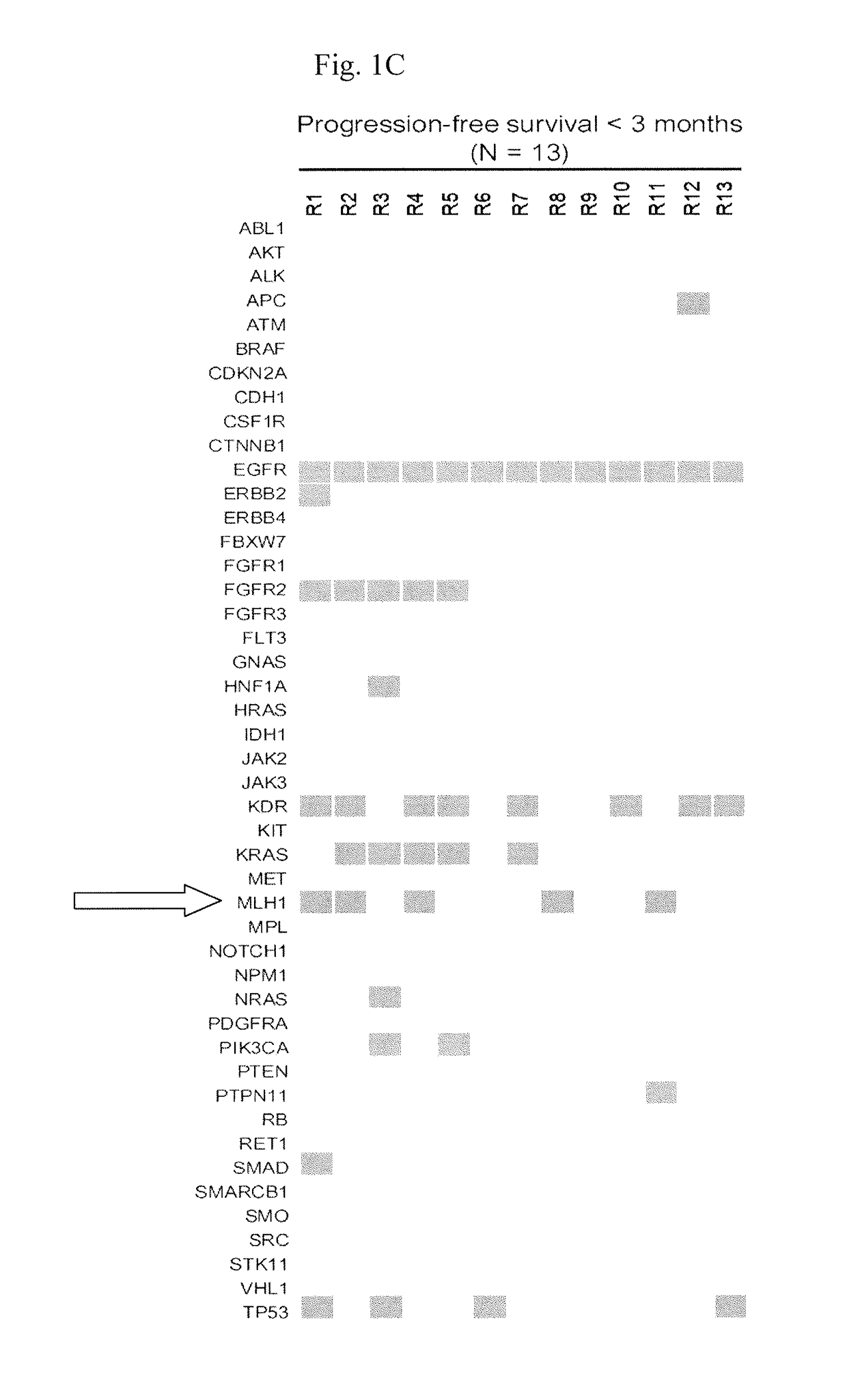Method for evaluating the efficacy of an egfr-tki treatment
a cancer treatment and efficacy technology, applied in the field of cancer treatment efficacy evaluation, can solve the problems of poor egfr-tki resistance intrinsic egfr-tki resistance in patients supposed to be responsive, high incidence rate of lung cancer, poor treatment effect, etc., to achieve short progression-free survival, poor efficacy, and treatment effect good
- Summary
- Abstract
- Description
- Claims
- Application Information
AI Technical Summary
Benefits of technology
Problems solved by technology
Method used
Image
Examples
example 1
Preparation
[Patients and Study Design]
[0052]Patients were included if they had primary lung adenocarcinoma harboring the L858R mutation without a co-existing T790M mutation in EGFR and received their first-time EGFR-TKI treatment at Taipei Veterans General Hospital during the period from January 2009 to January 2013. Patients who had prior EGFR-TKI therapy or received EGFR-TKI in combination with other anti-cancer treatment were excluded. Patients who had adequate tumor specimens for further molecular testing were enrolled. This study was approved by the Institution Review Board of Taipei Veterans General Hospital.
[0053]The size of the tumor is monitored for at least two months after the initiation of EGFR-TKI therapy and usually measured approximately three months after the initiation of treatment. If tumors progressed within the aforesaid period, we considered that the treatment was clinically ineffective and that these patients presented primary (or intrinsic) resistance. To disc...
example 2
-Gene Mutation Profiles of EGFR L858R-Positive Lung Adenocarcinomas
[0056]Next-generation sequencing (NGS) was used to interrogate mutations within hotspot regions of 46 cancer-related genes in lung adenocarcinoma samples from 13 and 16 EGFR-TKI-treated patients who had short (1 year) PFS, respectively.
[Next-Generation Sequencing]
[0057]Genomic DNA from FFPE tumor tissues was quantified using the Qubit® dsDNA HS Assay Kit and the Qubit® fluorometer (Life Technologies); 10 nanograms were amplified by multiplex PCR using the Ion AmpliSeq Cancer Panel Primers Pool (Life Technologies). PCR amplicons were ligated with barcode adaptors using the Ion Xpress Barcode Adapters 1-16 Kit (Life Technologies), and subjected to emulsion PCR. Template was prepared by the automated Ion OneTouch System using the Ion OneTouch 200 Template Kit v2 DL, and DNA was sequenced on a 316 chip using the Ion PGM Sequencing Kit v2 and the Ion Torrent Personal Genome Machine (PGM, Ion Torrent, Life Technologies). D...
example 3
D in Patients with Primary Lung Adenocarcinoma
[0062]In this example, a total of 158 tumors were subjected to MLH1 mutation analysis by direct sequencing of PCR products for examining the mutation status of MLH1 in a larger set of EGFR L858R-positive lung adenocarcinomas.
[PCR and Sanger Sequencing]
[0063]Exon 12 of the MLH1 gene was amplified from genomic DNA by PCR using a forward primer (SEQ ID NO: 05: 5′-CAGACTTTGCTACCAGGACTTGC-3′) and a reverse primer (SEQ ID NO: 06: 5′-CTGCCTAGCCCTGCCACTAG-3′). PCR products were sequenced using the Sanger method. DNA sequences were analyzed by the Mutation Surveyor software (SoftGenetics, State College, Pa.).
[Results]
[0064]Fourteen of the 158 tumors (8.9%) had a heterozygous change at nucleotide 1151 (FIGS. 2A and 2B) which results in the same V384D substitution in MLH1 as discovered in NGS screening. We were able to analyze genomic DNA from blood specimens of 4 patients and non-tumor tissue specimens from 1 patient, and all of these samples were...
PUM
 Login to View More
Login to View More Abstract
Description
Claims
Application Information
 Login to View More
Login to View More - R&D
- Intellectual Property
- Life Sciences
- Materials
- Tech Scout
- Unparalleled Data Quality
- Higher Quality Content
- 60% Fewer Hallucinations
Browse by: Latest US Patents, China's latest patents, Technical Efficacy Thesaurus, Application Domain, Technology Topic, Popular Technical Reports.
© 2025 PatSnap. All rights reserved.Legal|Privacy policy|Modern Slavery Act Transparency Statement|Sitemap|About US| Contact US: help@patsnap.com



